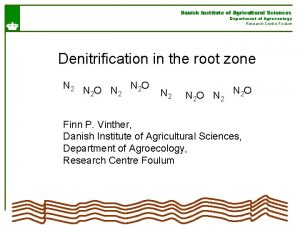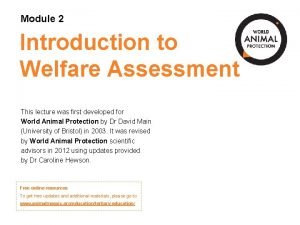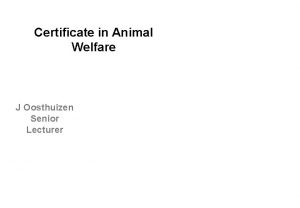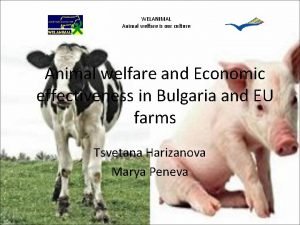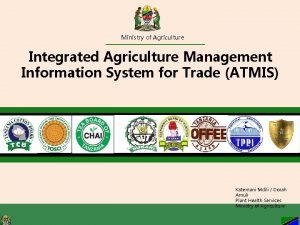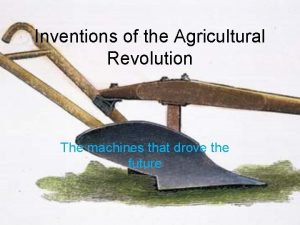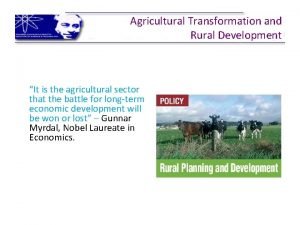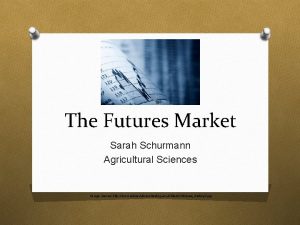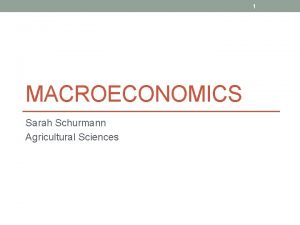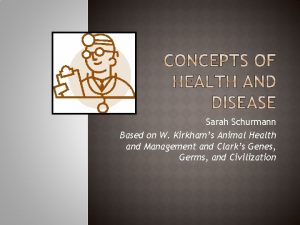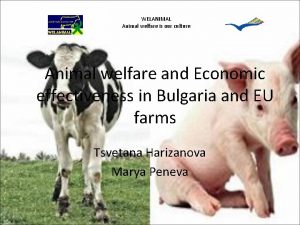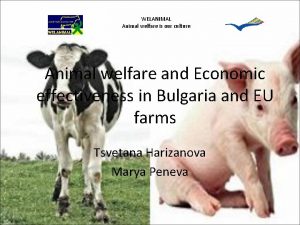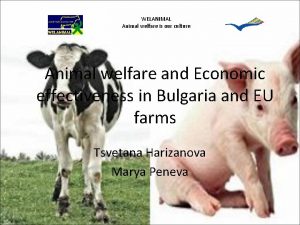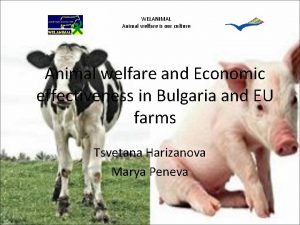ANIMAL WELFARE Sarah Schurmann Agricultural Sciences 1 Animal













- Slides: 13

ANIMAL WELFARE Sarah Schurmann Agricultural Sciences 1

Animal Welfare vs. Animal Rights • One of the most controversial aspects of animal agriculture is the question of the extent of the obligations that agriculturalists have in regards the welfare of the animals that they raise. 2

Animal Welfare vs. Animal Rights Often this debate becomes most apparent when discussing the difference between animal rights and animal welfare. • Animal welfare refers to the belief that animals can be used for human purposes so long as they are treated humanely and properly. 3

Animal Welfare vs. Animal Rights This is different from animal rights, which is the belief that animals have the same legal and ethical rights as human beings. • Those who advocate animal rights believe that animals cannot be penned or used for human purposes (including for food as well as for pets, research, hunting, transportation, or any other human purpose). 4

Temple Grandin • One of the most influential figures in the development of humane slaughter house designs is Temple Grandin. • Temple Grandin is a professor of animal science at Colorado State University and a leading expert in animal behavior. • Grandin has designed humane handling systems for roughly half of the cattleprocessing facilities in the United States and has worked closely with the meat industry to develop animal welfare guidelines. 5 Source: miridei. com

Temple Grandin • Some of Grandin’s recommendations for humane animal processing facility design include: • 1) Allowing for clear visibility while minimizing shadows and minimizing unnecessary motion (such as fabric that can flutter in the wind or a visible fan blade), as livestock have wide angle vision and are highly sensitive to motion and shadows. • Use of solid panels, un-slatted floors, and uniform lighting will reduce stress. • Animals are more likely to enter areas that are well-lit and of a uniform color. • Tight corners should be replaced by gently-curving chutes so that animals can see further ahead. 6 Source: miridei. com

Temple Grandin • Some of Grandin’s recommendations for humane animal processing facility design include: • 2) Minimizing loud noises, high pitched noises, or yelling due to the sensitive hearing of livestock. 7 Source: miridei. com

Grandin’s Recommendations • Grandin’s recommendations for humane animal processing facility design include (cont. ): • 3) Proper utilization of the flight zone and point of balance of meat animals. • The flight zone is minimal distance from animal that a handler can be before causing the animal to move (i. e. their personal space). Handlers should always be on the edge of the flight zone when working with an animal. • The point of balance is where a handler is in regards to the animal’s desire to move forwards or backwards; to make an animal move forward, the handler should always be behind the animal. • In curved chutes, the outer wall should be solid and the inner wall should allow the animals to see the handlers so that they can properly use the flight zone and point of balance to move animals forward. 8 Source: bqa. unl. edu

Grandin’s Recommendations • Grandin’s recommendations for humane animal processing facility design include (cont. ): • 4) Herding or flocking animals should not be isolated whenever possible. • However, meat animals should be allowed to walk single-file to prevent them from being able to turn around. • Animals are more willing to move into areas in which they can see animals that are already there. 9 Source: bqa. unl. edu

Source: www. milkproduction. com • Grandin’s designs utilize gently curving chutes so that cattle can see ahead. • Uniform color and lighting reduce stress. • Handlers are able to safely move cattle using their point of balance and flight zone. 10 Source: designandviolence. moma. org

Grandin’s Recommendations • Some of Grandin’s recommendations for humane animal processing facility design include (cont. ): • 5) The presence of another animal may calm an animal that needs individual attention (e. g. for veterinary procedures). 11 Source: www. tlu. edu

Grandin’s Recommendations • Some of Grandin’s recommendations for humane animal processing facility design include (cont. ): • 6) Contact with people should always be gentle and calming whenever possible. • Employees that work with animals should be specifically trained in this manner. • Animal handlers are more humanely effective when they exert dominance over meat animals, meaning that they reflect the ‘boss animal’ hierarchy of herding/flocking animals (this does not mean that they beat an animal into submission but reflect the demeanor and actions of the lead animal in a group). 12 Source: www. tlu. edu

Grandin’s Recommendations • Some of Grandin’s recommendations for humane animal processing facility design include (cont. ): • 7) Restraint devices (such as a squeeze chutes) should not cause pain and should be gradually introduced. • Meat animals should be trained to voluntarily submit to handling procedures through rewards and proper handling. • Feed can be used to facilitate training. 13 Source: www. tlu. edu
 Autonome fahrzeuge modul in der fu informatik
Autonome fahrzeuge modul in der fu informatik Plant cell vs animal cell venn diagram
Plant cell vs animal cell venn diagram Animal rights vs animal welfare
Animal rights vs animal welfare Plant vs animal cells
Plant vs animal cells Danish institute of agricultural sciences
Danish institute of agricultural sciences Human sciences vs natural sciences tok
Human sciences vs natural sciences tok Animal welfare continuum
Animal welfare continuum Higher certificate in animal welfare
Higher certificate in animal welfare Welpets
Welpets Animal nutrition grade 11
Animal nutrition grade 11 Www.atmis.kilimo
Www.atmis.kilimo Agricultural revolution inventions
Agricultural revolution inventions Lesson 2 the neolithic revolution
Lesson 2 the neolithic revolution Agricultural transformation and rural development
Agricultural transformation and rural development




